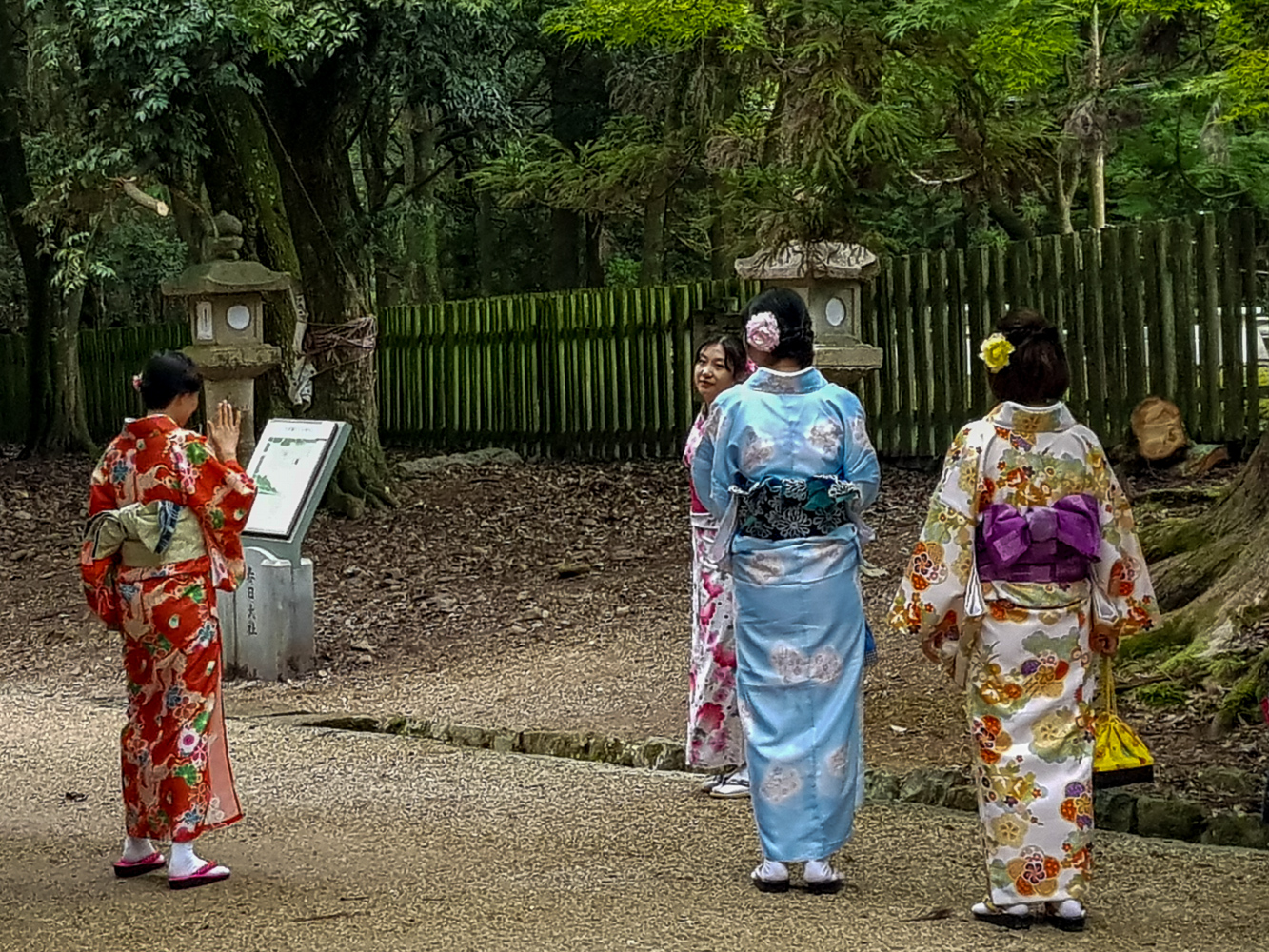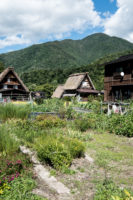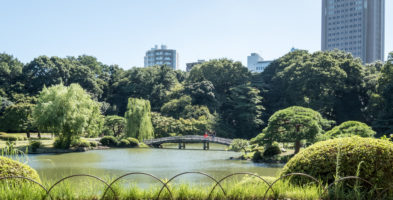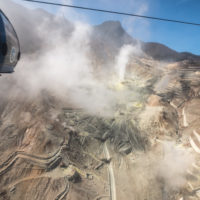9th September 2018
After missing the connecting train from Osaka we find the platform for the next bullet train to Kyoto in the unreserved section – fortunately there are frequent trains and the seat is still comfortable. A taxi ride through central Kyoto on a busy Saturday morning gets us to the Hotel Solaris. The room was nice but very small and no room for 2 suitcases – one has to be upright in the passage. The best part is the Onsen in the basement – my skin has never felt so good. The location turns out to be excellent as it is in Pontocho where there are old narrow streets and full of restaurants and bars.
We explore the basement arcade up the road with the entrance to the subway – it is full of shops and mini supermarkets. We buy food for breakfast, milk and tea. Izakaya Restaurant is across the road, and we have a seat at the counter and watch the chefs at work. They have a good selection of oden, yakitori, sashimi and tempura items, featuring vegetable, fish, chicken and beef. Their sake was also particularly good.
On Monday we decide to walk to temples through an area of small streets and beautiful little houses, shops, and restaurants. There is a nice health food cafe for lunch called Choice where we talked to a Canadian lady and get some interesting tips on where to go. We visit Chion-In Temple and Yasaka Jinja Sharine which are incredible wooden buildings all painted with vermillion and with manicured Japanese clipped gardens. Then we discover the most interesting streets winding through Higashiyama on our way to Kennin-ji i a historic Zen Buddhist temple at the end of Hanami Lane. It is considered to be one of the so-called Kyoto Gozan or “five most important Zen temples of Kyoto”

We walk back over Shinjo Gion Bridge but have tea at a fruitcake called Shoo. The cakes are amazing decorated with colourful icing all reminiscent of fruit.
For our walk back we amble through Gion Pontocho, and a little street called Ponto-chō which has a lots of little restaurants and bars on the river. It starts to rain – not so unusual and we decided to go back there for dinner on the river where we sit out on the balcony with a view of the lights and people walking along the river. It is somewhat expensive, so we order to budget and fortunately it does not rain so we are able to enjoy the meal. The street is a hive of activity as we walk home with beautiful little shops and with lanterns and sushi barrels. Our Onsen is always a welcome ritual before bed.
Tuesday We find the train to Inari station is nearby and join fellow temple pilgrims and alight at a little workers town – all grey dull with power lines and traffic – no great ascetics here. We follow the others along the side of the road and on the occasional footpath grateful to be separated from the cars and trucks. We find Fushimi Inari Shrine and the 5,000 Vermilion Gates – the very famous temple full of vermillion posts. The recent typhoon has done a lot of damage to the gates and the trees, but we are able to see quite a few gates in their brilliant vermillion colour and even find one or two that might have been officially close that you can actually get o picture of without another person in shot. – an absolutely amazing place to visit but of course there are always going to be lots of other tourists a fact that you just have to accept if you want to see these places.

Tōfuku-ji temple and garden is nearby so instead of a train stop we walk along a pleasant street weaving in and out of pathways and lanes to the temple. This is more like it – not very many people and a beautiful garden and raked stone and rock garden. In another building there is a moss garden and terrariums. The grounds are a big garden with beautiful trees almost in autumn colours and a sunken garden. We decide to go back to Kyoto for lunch and go to the Nishiki markets. Seating is difficult and eating while walking is not really an acceptable practice although we do sample an octopus ball and other marine creature concoctions while exploring the market. We do find a milk crate and a chair and order a local delight at one of the stalls. Getting rid of rubbish is another obstacle because there are no bins, but the shopkeepers will take the rubbish for you.
I have heard that there is a knife shop in the market and eventually we find it cash only and no tax paper, but I buy 2 knives a sashimi suitable for beef and a vegetable knife both engraved with my name – they are steel but now I wish I had got the stainless steel vegetable one for slightly extra as it is very hard to keep the rust under control.
Next up is a Washi (paper) shop where we explore and get overwhelmed by all the beautiful printed-paper. I also find a beautiful fabric shop on the way home but put it off til later only to realise that these shops are mostly individual and if you like something you should buy as you won’t see it again.
We find our dinner downstairs in a very well-worn restaurant that turns out to be part of a hotel. The place seemed artistic but worn had nice duck and pork in garlic and a really great salad. You just never know, and it was just up the road from us – nice food! Back to the hotel after exploring the liquor shop opposite and it is a particularly good shop – looking to satisfy my newly acquired taste for yuzu wine.
Wednesday 12th
The train to Nara is on the JR network from Kyoto.
Nara City is located in the centre of Nara Prefecture and is an area where there are many shrines and temples. In fact, eight shrines and temples found within the city are registered as World Heritage Sites and are known as the “Historic Monuments of Ancient Nara”. The city as a whole shows the true depth of its fascinating history.
Did you know that until the 7th century Japan had no permanent capital? The capital was moved with the passing of each emperor so that his successor would not be ill-fated by the death.
The practice ended under the influence of Buddhism and with the Taika reforms of 646. The true aim of the reforms was to bring about greater centralization and to enhance the power of the imperial court.
The official capital was finally established in 710 and Nara, which was then known as Heijōkyō, was chosen as the site. Once the selection was made, Nara experienced an unprecedented construction boom. The temples Yakushji, Asuakdera – also known as Hokoji (now Gangoji) and Daikandaiji (now Daianji) were moved to Nara and Kofukiji was built by Fujiwara Fuhito, the nobleman who orchestrated the move to Nara. Nara remained the capital city until 784. The period between 710 and 794 is referred as the Nara Period in Japanese history.
When a priest by the name of Dōkyō managed to seduce an empress and nearly usurp the throne, it was decided to move the court to a new location, out of reach of Nara’s increasingly powerful clergy. This led to the new capital being established in Kyoto, where it remained until 1868.
On arrival at Nara we find that there is not many places to eat at the station and we go to the tourist office where we eventually find an English speaking consultant who puts us on track with a Nara pass, so off we go to the Todaiji Temple– fortunately we manage to get a delicious bento box for lunch in a cafe near the entrance. As we approach the gates, we are astounded to meet so many deer. They are everywhere a population explosion! They are begging for food from all the tourists and quite willing to eat your hat or bag.
We enter the gates, and it is an amazing site, the temple is made of wood and is huge – once you walk the path you enter and there is the most enormous gold Buddha Statue. There are many tourists and pilgrims, and you can view some incredible ceramics as you walk around the alter as well as being able to buy the obligatory blessings and souvenirs that are all of a ‘Buddhist nature’.
We leave the temple and find that you can walk along various paths to the other sites we choose to go to Nigatsudo Hall which is to the east of the Great Buddha Hall and up on the side of Mount Wakakusa overlooking the city of Nara. The footpath and many stairs leading to Nigatsudo Hall are challenging but, when you finally make your way up to the large front platform of the hall, you get the most spectacular view of Nara. There are many lanterns around the hall.
Next, we walk through Nara Park home to all the deer – it is a nice walk and we are in time to see Kasuga Grand Shrine: a Shrine Decorated with Lanterns and this place is absolutely incredible decorated with 1000 lanterns with vermillion posts. There is a dark room where with the illusion of mirrors you seem to be floating in a infinite room of lanterns – quite spectacular. We leave the temple and as time has flown, we decide to take the bus and do a loop of the town so we get to see the Pavilion that we didn’t have time for. We make it back to the station but I am unable to find my JR pass and so I am trying to figure out what to do – eventually John finds that I have put it in an obscure pocket so we are able to happily continue our journey with relief. We havedinner at restaurant further up the road with food sets and karaoke in the next room.
Thursday 13th September. We caught the Inari train that went to Arashiyama to get the Sagano Scenic Railway (嵯峨野観光鉄道, also known as the Sagano Romantic Train. We had coffee in the Romantic Cafe where there were old trains. The old steam train runs along the scenic line along the Hozugawa River between Arashiyama and Kameoka. It’s an old fashioned train with uncomfortable slatted wooden seats that is fairly noisy and winds through the mountains at a relatively slow pace, taking about 25 minutes to make the seven kilometre journey and runs along a river and through the forested ravine and into rural Kameoka. We were able to see areas that had been flattened by the typhoon, but it is hard to image how anyone can access these hills in hilly impenetrable country.
Arriving back in Arashiyama we went in search of lunch and the Bamboo Forest. We found some street food and had a few skewered kebab things – I also found a hair ornament shop – expensive but very interesting. To get to the Bamboo Forest we first went into Tenryu-ji garden tiered Japanese gardens around a pond, which then led to the Sagano bamboo walk. The walk was very crowed but very beautiful – that was the day we found someone’s JR pass.
We had afternoon tea and dessert at a matcha shop in Gion and then dinner at Gion in a small restaurant where you sat at the bar and saw the chefs cooking. We managed to see a couple of geishas down the street on their way out. Interesting walk around Gion at night enjoying all the secret little bars and restaurants. Once again, a nice onsen in the morning and night – so nice and my skin is looking great.
Friday 14th September – The Fushimi Sake District (伏見) is a charming, traditional sake brewing district along the willow-lined Horikawa River in southern Kyoto. Revered for the clean, soft water that flows in abundance from the river’s underground springs, the district is home to nearly 40 sake breweries. Alongside Kobe’s Nada District, Fushimi has been a leading sake brewing district in the country.
Among the local breweries is industry giant Gekkeikan which was founded here in 1637. Many of the district’s buildings preserved their traditional appearance with wood and white-plaster walls. A few of the breweries in the area are open to the public and offer shops where you can taste and purchase their products (including some exclusive items not available elsewhere), restaurants and museums.
We had tea at the little tea shop and then went for a tour of the brewery and museum and a tasting of 3 different sakes and a little sample to take home.
We walked along the river and had a really good set lunch at hostel in an interesting arcade. Later we have dinner at Pizza bar and drinks after at British pub and coffee at Starbucks with a souvenir mug! Walked home to our hotel along the river enjoying our last Onsen.
Link to gallery



